While primarily celebrated for its transformative contributions to the gaming industry, Unity also reveals a significant yet underexploited capacity for web development. As a distinguished Unity development company, we aim to highlight Unity's robust capabilities in this field. Our guide is designed to illustrate the circumstances under which Unity serves as a beneficial resource and emerges as an extraordinarily potent instrument for crafting web experiences. Unity's prowess in rendering superior 3D graphics and offering an immersive user experience positions it as a multifaceted asset for web developers.
The versatility of Unity web game development extends beyond traditional gaming to enrich web experiences. Professionals in Unity web development leverage this technology to create dynamic and interactive web platforms. By integrating Unity web technologies, developers enhance web design, ensuring users enjoy engaging and visually appealing online environments. The application of Unity in web development showcases its ability to transcend its gaming roots, proving indispensable for innovative web solutions.
Employing Unity for web projects facilitates a blend of game development techniques with traditional web development, resulting in unique and engaging web applications. The convergence of Unity web and game development expertise enriches the web landscape, offering users experiences that are not only visually captivating but also highly interactive. This strategic approach underscores the value of Unity in elevating web design and development, affirming its role as a cornerstone in the evolution of web technologies.
How Can You Use Unity In Modern Web Development?
Unity is increasingly becoming a valuable asset in the world of web development. The main question that arises: how do developers leverage it to create engaging online experiences, if initially it was designed for game development? Here is the answer.
Interactive 3D Experiences
Unity excels at crafting immersive 3D environments, a strength that web developers can leverage to construct interactive 3D websites. Such sites prove especially beneficial for sectors such as real estate, automotive, and education, where users' ability to explore products or concepts within a three-dimensional space enhances their understanding and engagement. By incorporating Unity's capabilities into Unity web development, developers are able to deliver rich, engaging content that transcends traditional web experiences.
The intersection of Unity web game development and other industries illustrates how versatile Unity's technology is, enabling the creation of detailed, interactive platforms that serve a wide range of purposes. Through Unity web projects, the boundaries of web design are expanded, offering users a more dynamic and immersive experience. Unity's integration into web development marks a significant shift towards more interactive and visually appealing websites, setting a new standard for what is possible in web design and development.
VR and AR Integration
With the escalating interest in VR and AR technologies, Unity's seamless integration capabilities position it as the preferred platform for developing web-based VR and AR experiences. Businesses aiming to provide virtual tours, interactive training modules, or pioneering marketing experiences find Unity's tools especially relevant. The ease with which Unity facilitates the creation of these immersive experiences underscores its pivotal role in Unity web development.
Unity's prowess extends into the arena of Unity web game development, where its capabilities in VR and AR can transform standard game experiences into rich, interactive journeys. By leveraging Unity for web development, professionals can craft experiences that significantly enhance user engagement and retention. Unity's application in creating immersive web-based environments demonstrates its unmatched versatility in web design, setting a new benchmark for interactive web experiences.
Gaming Elements in Websites
Gamification stands as a compelling trend within web design, striving to amplify user engagement and deliver experiences that distinguish a company from its competition. Unity, with its deep gaming heritage, is ideally suited for integrating game-like elements into websites, thereby elevating user interaction and retention. The incorporation of such elements into Unity web development projects transforms standard websites into engaging platforms that captivate users.
By applying principles of Unity web game development, developers infuse websites with interactive and immersive elements that make navigating online spaces more engaging. Unity's adeptness in creating dynamic web environments leverages its gaming foundation to enhance web design, offering users an experience far beyond the conventional. The strategy of embedding gamified elements into web development underlines Unity's significant role in redefining user interactions online.
High-Quality Visuals and Animations
Unity's advanced rendering engine is a cornerstone for producing breathtaking visuals and fluid animations, enhancing the aesthetic allure of websites. This enhancement not only captivates users but also engages them more deeply with the content. Through Unity web development, professionals can transform the visual and interactive aspects of websites, setting new standards in web design.
The implementation of Unity's capabilities in Unity web game development showcases how game-like elements and high-quality graphics can significantly improve user interaction and website appeal. By incorporating these elements, developers create more compelling and visually engaging web experiences. Unity's contribution to web development extends beyond traditional boundaries, introducing a level of sophistication and engagement previously unseen in web design.
Simulation and Training
Industries such as healthcare and engineering, where complex simulations are essential, find Unity's tools particularly advantageous for creating detailed, interactive simulations accessible through the web. This approach offers an accessible and cost-effective solution for training purposes. By utilizing Unity web development, these sectors can implement simulations that not only enhance learning and comprehension but also make training more engaging and interactive.
The application of Unity web technologies enables the seamless integration of interactive simulations into web platforms, ensuring broad accessibility that traditional methods may lack. This integration represents a significant advancement in web design, where the focus shifts towards creating more dynamic, informative, and engaging content. Unity's capabilities in game development further enrich the web development process, offering users an immersive experience that goes beyond conventional training tools.
The Core Features of Unity for Web Development
Unity stands as a formidable entity in web development, endowed with a suite of features that elevate it as an indispensable tool for crafting sophisticated web applications. Below is an exploration of Unity's key features that are especially advantageous for advancing web development projects:
Advanced 3D Graphics Engine
Unity's core is its advanced 3D graphics engine, enabling developers to generate high-quality 3D models, environments, and animations. This capability is fundamental for creating visually captivating web applications that significantly enhance user engagement.
Unity WebGL
With support for WebGL, Unity allows the deployment of 3D content directly into web browsers, bypassing the need for plugins. This accessibility ensures that Unity-based web applications are readily available to a broad user base.
Real-Time Rendering
Unity's real-time rendering feature allows for immediate visual feedback on environmental changes or object interactions, a critical aspect for web applications that thrive on dynamic content updates and interactive experiences.
Physics and Simulation
Including a robust physics engine in Unity is essential for developing realistic simulations and interactive experiences, making it particularly valuable for web applications focused on education, training, and simulation.
Asset Store and Extensibility
The Unity Asset Store offers an extensive range of tools that can be seamlessly integrated into Unity web development projects. Furthermore, Unity's flexible architecture permits the creation of bespoke tools and plugins, enabling developers to customize the development environment to meet specific project requirements.
Multiplayer and Networking
Unity also shines in its support for multiplayer features and networked interactions, facilitating the development of connected, social, and engaging web experiences. This feature underscores Unity's capability to enrich web design with complex game development mechanics and interactive elements.
Through Unity web development, these features come to the forefront, showcasing Unity's unparalleled ability to merge game development prowess with web development needs. This blend enriches Unity web applications and pushes the boundaries of traditional web design, setting new standards for what can be achieved in web development
Why Use Unity for Web Projects?
Selecting the right tools is crucial for the success of any web development initiative, and Unity has emerged as a surprisingly strong contender in this field. Here are four reasons why opting for Unity in web development projects is increasingly making sense:

Exceptional Interactive and Immersive Experiences. Unity shines in its capacity to forge highly interactive and immersive web environments. Leveraging Unity's advanced 3D graphics and real-time rendering, developers can craft captivating spaces that engage users deeply. This feature is particularly advantageous for sectors such as game development, real estate, education, and training, where drawing in and maintaining user interest is critical.

Cross-Platform Compatibility. The ability of Unity to support cross-platform development stands out as a major benefit within the multifaceted web development ecosystem. Unity enables the creation of web applications that deliver a seamless user experience across a variety of devices and platforms. This widespread compatibility streamlines development efforts and reduces costs, as developers can deploy the same codebase across different platforms, from desktops to mobile phones.

Robust Community and Ecosystem. UThe strength of Unity's community and the breadth of its ecosystem further enhance its appeal for web development. The Unity Asset Store offers an extensive array of resources, such as tools, assets, and plugins, that can expedite the development workflow. Additionally, the vibrant community provides essential support, tutorials, and documentation, facilitating the resolution of challenges and the acquisition of new skills.

Versatility and Scalability. The versatility of Unity is unmatched, extending beyond game development to encompass a wide variety of web applications, including interactive advertisements, educational platforms, and data visualization tools. Unity-based applications can scale effortlessly, ranging from straightforward interactive projects to intricate, sophisticated simulations.
Through Unity web development, these advantages are brought to the forefront, showcasing Unity's unparalleled ability to merge high-end game development techniques with the demands of modern web design. This fusion not only elevates Unity web projects but also redefines the standards of what can be achieved in web development, enhancing the scope and quality of web design.
The Main Unity Limitations for Web
Unity's foray into web development brings with it a set of challenges that necessitate careful consideration. Recognizing these obstacles is vital for both the providers of Unity app development services and their recipients aiming to efficiently utilize Unity's full potential. Here are the four primary challenges encountered when deploying Unity web development projects.

Performance and Optimization. Achieving optimal performance remains a significant hurdle in leveraging Unity for web development. The engine's sophisticated capabilities, notably in handling intricate 3D graphics and executing real-time rendering, demand considerable resources. Such demands may induce performance bottlenecks, especially on devices with limited capabilities or within certain browsers. Developers are thus tasked with implementing adept optimization strategies to ensure consistent, fluid performance across diverse platforms.

Steep Learning Curve. The extensive array of features that Unity offers is accompanied by a steep learning curve. This is particularly true for individuals new to 3D development or those unfamiliar with game engine paradigms. Gaining proficiency in Unity's environment, scripting with C#, and navigating its vast toolset and features can be daunting and requires a substantial investment of time and effort.

File Size and Load Times. The development of web applications via Unity may result in substantial file sizes, which in turn can prolong load times. Such delays can detract from the user experience, a critical consideration in web spaces where swift content delivery is anticipated. Balancing the delivery of high-quality content with the necessity for manageable file sizes to enhance load times is a crucial task for developers.

Limited Browser Support. Despite Unity's support for WebGL, enabling direct deployment to web browsers, challenges in browser support and compatibility persist. Not all features may perform uniformly across different browsers, and discrepancies in performance are not uncommon. Addressing these variations demands thorough testing from developers, along with potential adjustments in features or design to achieve widespread compatibility.
Navigating these challenges in Unity development underscores the importance of this software in the broader context of web and game development. It also highlights the evolving nature of web design, where Unity's role is increasingly significant, pushing the boundaries of what is achievable in creating rich, interactive web experiences.
Web Projects Developed Using Unity: Case Studies
Case 1: Connect Configurator by Tilbury Douglas

Tilbury Douglas has teamed up with Unity to introduce the Connect Configurator, a pioneering digital tool to transform the construction sector. This web-based platform harnesses Unity's cutting-edge real-time 3D (RT3D) technology to enhance the process of generating building designs from standardized layouts, marking a significant leap forward in Unity web development for the construction industry.
The introduction of the Connect Configurator marks a pivotal shift in the approach to building design. It enables the composition of entire structures through a web interface, where users can assemble buildings by selecting individual rooms outfitted with a variety of construction components. This method utilizes prefabricated models alongside advanced 3D technologies facilitated by Unity, offering an unprecedented level of detail in project visualization at the initial stages of development.
An essential attribute of the Configurator is its capacity to instantly deliver critical data regarding costs, carbon emissions, and projected timelines. This feature empowers users with the ability to make informed decisions based on real-time, data-driven insights. Such a capability is instrumental in minimizing the common occurrence of extensive revisions during the detailed design phase, thereby optimizing the design process and significantly reducing the time traditionally required for design elaboration.
By leveraging Unity web technologies, the Connect Configurator exemplifies the transformative potential of Unity in web development, specifically within sectors not traditionally associated with game development or web design. This innovation underscores the versatility of Unity web platforms in offering sophisticated solutions that streamline complex processes, setting new benchmarks in efficiency and sustainability in construction design.
Case 2: Security X-ray Simulation Platform by Program-Ace

Program-Ace, a distinguished software development firm, collaborated with a leading UK Customs and security enterprise to transition their Security X-ray Simulation Platform from a desktop-based application to a web-based one. This strategic move was designed to enhance the proficiency of airport security personnel, aiming to diminish security breaches through superior training and assessment tools. The shift to the web facilitated the creation of life-like X-ray simulations paired with an extensive library of potential threats, fostering immersive learning environments critical for the recognition of security threats.
Incorporating customizable scenarios and a sophisticated training management system into the web platform, Program-Ace offered personalized training experiences coupled with efficient performance monitoring. This degree of personalization, along with instant feedback provided by interactive modules, drastically improved the training methodology.
Utilizing Unity for the web development of this platform, Program-Ace realized numerous advantages, including a 30% reduction in training expenses, a 10% increase in the efficacy of threat recognition, and a 20% reduction in security breaches. The platform's adaptability and scalability, in conjunction with its adherence to regulatory standards, established it as an indispensable resource for airports, customs authorities, police forces, and governmental bodies.
The success of this project underscored Unity's capacity to facilitate the development of complex, impactful web-based training solutions, demonstrating the profound impact of Unity web and game development expertise in enhancing web design and development practices.
Case 3: Globe-Trotter's Luxury Shopping Experience

Globe-Trotter, an esteemed luxury luggage manufacturer, embarked on a collaboration with SmartPixels, an innovative Parisian startup, to revolutionize the online retail experience for their clientele. Utilizing Unity's advanced technology, they introduced a groundbreaking online service for customizing luxury luggage, thereby redefining the presentation and customization of upscale products within the digital marketplace.
The service featured a real-time 3D configurator that rendered customized luggage designs in photorealistic detail, allowing customers to view their creations from every angle through a comprehensive 360-degree feature. This depth of visual detail played a pivotal role in enabling customers to make well-informed decisions regarding their significant investments.
Upon the completion of their design process, customer specifications were forwarded to Globe-Trotter’s artisanal workshop located in Hertfordshire, England. There, each luggage piece was handcrafted with the utmost precision and subsequently dispatched to customers, fully prepared to accompany them on their future travels. This fluid melding of digital innovation with age-old craftsmanship underlines the transformative impact of Unity on the luxury e-commerce landscape, rendering it more dynamic and tailored to the needs of the consumer.
Getting Started with Unity for Web Development
For companies looking to dive into Unity for web development, the approach involves careful planning, resource allocation, and a strategic mindset. Here's a structured way for a company to begin its journey in harnessing Unity for innovative web projects:
1. Assemble a Skilled Team:
The first step is to assemble a team of specialists with expertise in Unity and web development. This may involve hiring experienced Unity developers, 3D artists, and web developers who are familiar with Unity’s WebGL platform. Ensure that the team also has a good understanding of C# scripting and cross-platform development.
2. Invest in Training and Development:
Even with a skilled team, continuous learning is key. Invest in training your team in the latest Unity features and best practices, especially those related to web development. This can be through workshops, online courses, or attending Unity conferences and webinars.
3. Setup and Optimize Development Environment:
Equip your team with the necessary tools and software. This includes installing the latest version of Unity and setting up a robust development environment. Ensure that the team has access to high-performance computing resources to handle Unity’s resource-intensive tasks, especially when working with complex 3D graphics.
4. Project Planning and Prototyping:
Start with detailed project planning. Define the scope, objectives, and timeline of the web development project. Encourage your team to create prototypes using Unity, which can be a valuable step in visualizing concepts and refining ideas before full-scale development begins.
5. Focus on Performance and Optimization:
Given Unity’s resource-intensive nature, emphasize the importance of optimization for web platforms. This includes optimizing 3D models, and animations, and ensuring efficient scripting. Regular performance testing across various browsers and devices is crucial to maintain a smooth user experience.
6. Regular Testing and Quality Assurance:
Implement a rigorous testing and quality assurance process. This should cover not only functional aspects but also performance across different web browsers and platforms. Consider automated testing tools to streamline this process.
7. Collaborative Development and Iterative Feedback:
Foster a collaborative development environment. Encourage regular team meetings, peer reviews, and iterative feedback sessions. Collaboration tools and version control systems like Git can aid in managing the development process efficiently.
8. Deployment and Continuous Improvement:
After thorough testing and quality checks, deploy the project using Unity’s WebGL build settings. Post-deployment, focus on continuous improvement based on user feedback and analytics. Keep the project up-to-date with the latest web standards and Unity updates.
9. Engage with the Unity Community:
Encourage your team to engage with the Unity community. This can provide valuable insights, help in troubleshooting, and keep your team updated with the latest trends and best practices in Unity development.
What is the Future of Unity in Web Development?
As we look to the future, we believe that Unity's role in web development is set to expand significantly, focusing on three key areas:
Advancements in 3D and Interactive Content
The growing demand for interactive web experiences positions Unity as a crucial tool. Known for its 3D rendering capabilities, Unity is likely to drive innovation in creating immersive and engaging web content, especially in gaming, education, and e-commerce.
Expansion of AR and VR on the Web
Unity's strong support for AR and VR will play a significant role in their integration into web applications. As these technologies become more accessible, Unity is poised to lead the way in offering immersive AR and VR experiences within web environments.
Integration with Emerging Web Technologies
Unity is expected to evolve through integration with emerging web technologies like WebAssembly and HTML5. This advancement will enhance Unity's performance on the web, allowing for more sophisticated and efficient web applications.
Cooperate with Top Unity Experts for Innovative Experiences
Unity is full of surprises, as it can play different roles in the world of software engineering. Whether you need to develop a Unity-powered game, simulation, or interactive graphics, the first step you need to take is to cooperate with true Unity experts.
Program-Ace, a software development company with more than three decades of experience, has been working with Unity from the very beginning. We know how to unlock its versatile potential for the benefit of your development. Feel free to contact us if you want to learn more about our Unity development capabilities.













